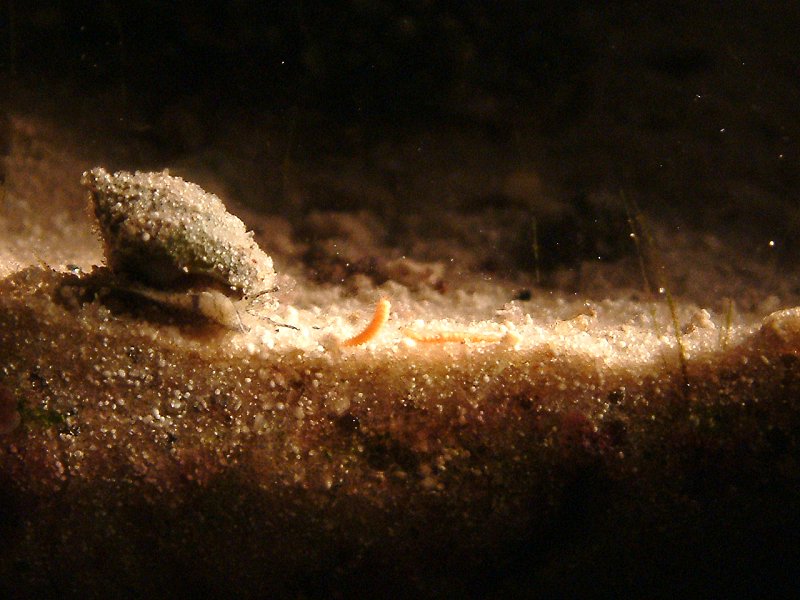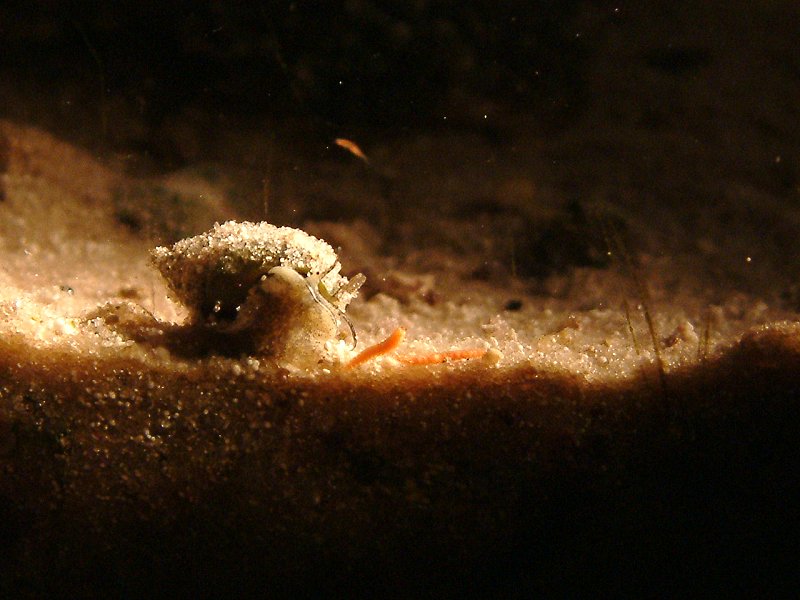

|
|
|
|
|
#1
|
|||
|
|||
|
Swimming worms
Hi Ron,
I saw something brand new tonight. Lights were out, and I was feeding my sun coral with a flashlight to see. Suddenly I saw these very short orange worms swimming through the water. Then I saw white ones. There were probably 20 or 30 in my 55g, all scurrying through the water, swimming up to the surface... just hanging out. I did try to get some pictures, and went ahead and shot some video. The orange guys were very thin, maybe 2mm wide, and about 5 - 6mm long. Unreal to see something like that after a couple of years of observing. The white ones were longer, maybe 3/4" long, but just as thin. They would wriggle their bodies like a snake at high speed. And they moved relatively fast, as they swam in the water. The powerheads were all off, so there was no current to move them nor to fight against. Here are two pictures. I'd say that they are roughly the size of a maggot.   This second picture, you can see one darting through the water right over the nassarius snail. I would never have gotten it in the picture if I'd tried, it flew through as the shutter saved this moment in time:  And finally, here's a 1 minute video so you can see these guys in action, up near the surface. http://www.melevsreef.com/video/afterdark.wmv 5megs I know you get a ton of requests, so let me thank you in advance. I just can't get over seeing this for the first time with so many years of night-observation on my part.
__________________
Marc Levenson - member of DFWMAS |
|
#2
|
|||
|
|||
|
Hi Marc,
What you have seen has actually been discussed here many times.  This is the spawning pattern of several different types of polychaete worms. When the worm becomes gravid it undergoes several morphological changes that allow it to swim better. There are two basic patterns. In the first, the worms will swim to the surface and the body will rupture releasing gametes into the water. This type of spawning is naturally cued to lunar cycles and at the right time, large numbers of worms will be up in the water spawning and disintegrating releasing large numbers of eggs and sperm. Fertilization occurs in the water, and the larvae develop in the plankton. These worms are referred to as heteronereids or epitokes, and this pattern happens in the polychaete families Nereidae, Eunicidae and some others. In the second pattern, the female worm grows a clone, typically from the back end of the worm. This clone has the swimming modifications, but it lacks a gut. It is filled with stored food (fats). Fertilization occurs in the sediments or rocks, and the eggs are glued to the clone which breaks free from the female and swims away. Typically the clone lives for about two weeks or so, and during this time it disperses to new habitats. The baby worms grow to a small juvenile stage fastened to the belly of the clone. When the clone "runs out of gas" the babies are released into their new habitat. These worms are typically referred to as swarmers, and this pattern is characteristic of worms in the family Syllidae. Do a search of this forum on "epitoke" or "swarmer" and you will find some of the earlier threads. Unfortunately all of the earlier images have been deleted. Here is image of a syllid swarmer that I took while it was swimming in the plankton (and this was fun to try to get while we both were floating in the water). This animal was about 2 inches long.  This was a much smaller worm collected with a plankton net; the eggs are the dark blurry mass in the center.  In some species the swarmers stay in the sediments. This small worm was discovered in some sediment samples my students were working through during my invert class last summer. 
|
|
#3
|
|||
|
|||
|
Ron, thank you for the full answer! I knew you'd know, but I wasn't even sure where to begin searching.
Plus, you know your forum needs a new thread every hour.  Hey, remember the brown bubble I asked you about a few days ago? You said those came from a polychaete worm too. In this case, it is a different version/species, right?
__________________
Marc Levenson - member of DFWMAS |
|
#4
|
|||
|
|||
|
Hi,
Yes, the two methods of reproduction belong to two different types of worms. |
|
#5
|
|||
|
|||
|
Unfortunately all of the earlier images have been deleted.
I was told that all attachments in some forums would be allowed again. I'd think your forum should meet that qualifier. Have you talked with any on the Staff about that likelihood? If I added this critter to my ID page, do you have a page I can link it to? Or can I take your response from this thread and build a page for my visitors?
__________________
Marc Levenson - member of DFWMAS |
|
#6
|
|||
|
|||
|
Quote:
If I added this critter to my ID page, do you have a page I can link it to? No. Or can I take your response from this thread and build a page for my visitors? Yes. |
|
#7
|
|||
|
|||
|
Thanks!
__________________
Marc Levenson - member of DFWMAS |
|
#8
|
|||
|
|||
|
Did you have to add the sound track?!?!. Making the rest of us look bad. Stop it, we don't need any help.

|
|
#9
|
|||
|
|||
|
hehehe. It was funny. Now you got me wanting to view it again!
__________________
Marc Levenson - member of DFWMAS |
|
#10
|
|||
|
|||
|
Ron, last night I saw at least 50 tiny red swimming worms in my 29g. They were almost swarming, and about the size of frozen Cyclop Eeze. Very very tiny, with the shape similar to a rice grain, but the 'tail' came to a point. They were reddish colored.
I find it very strange, fascinating and odd that I'm seeing these creatures in the last few days, now in both of my tanks although plumbed separately. Is this purely coincidental, or am I observing some type of annual spawning even possibly?
__________________
Marc Levenson - member of DFWMAS |
|
#11
|
|||
|
|||
|
Hi Marc,
I think you are seeing spawning events in different species that are cued by the same external changes. Happens all the time in the real world. 
|
|
|